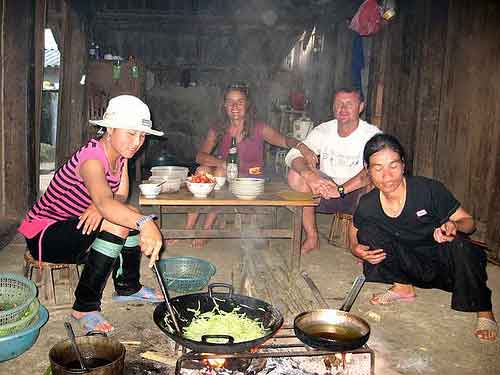|
Homestay provides
lasting memory of scenic Vietnam
Top-class hotels
and resorts may provide visitors to
Homestay and community-based tourism
models are a mainstay of the worldwide tourism industry. This style of travel
allows visitors to stay with a local family for a true insight into their
everyday life. The concept has become more popular in recent years, thanks in
part to the fact that it ties tourism, the environment and community
together.
Promising destinations
Ten years ago,
Ta Van, a village 8km from
While Loi takes tourists around to
introduce local culture and life to them, his mum stays at home preparing a
meal, which is sometimes simply a bowl of Vietnamese noodles with pork meat
(instead of chicken or beef like in cities) and some drinks.
The house is traditional, with many
everyday items hanging on the walls, such as a bunch of dry rice and a
traditional costume. All such houses are very clean with standard toilets,
mattresses and curtains to satisfy the basic accommodation needs of tourists.
Experiencing community-based tourism
in the Mekong Delta is highly recommended by many tourists. Patrice Nathan, a
French tourist, had much praise for Hung homestay in Can Tho City: “My
friends and I spent two nights in Hung homestay and I think that is a great
way to see this land. Hung is great man, has excellent English, a crazy sense
of humour and did everything to ensure that we enjoyed the visit. Hung also
provides a boat trip to Cai Rang floating market and a walking tour through
his local village which is fun and informative.”
In central
In many places, after developing
community-based tourism, local people’s income has been improved
considerably; therefore, Vietnamese agents and authorities are aiming to expand
this model.
Much potential, but many challenges
After a visit to Cao Bang, tourists
may wonder why community-based tourism has not developed there – it has wild,
stunning landscapes, a diverse ecosystem, and a rich local culture with many
minority groups.
Nhan Thi Minh Thi, deputy director of
Cao Bang’s Department of Culture, Sports and Tourism, explained: “People here
are unfamiliar with the tourism business. We have carried out a community
tourism project in Pac Ngoi village, but we have not had the budget to
continue in another place.”
“Most of the people in Tu Ne are
Muong, but when we came here, they did not wear their traditional costume.
Wooden stilt houses had been destroyed to clear space to build concrete ones.
They were on the brink of losing their local characteristics,” said Le Thi
Van Hue, director of Cecad, which started the project of community-based
tourism in Tu Ne, in Hoa Binh province, in 2008.
Cecad sent people to Tu Ne to teach
people how to develop tourism by taking back their own traditional culture.
However, it did not work as they lacked the money to provide basic facilities
in the village; that is, until Huong Giang Travel joined them in 2011.
“Many people said they wanted an
authentic homestay; however, very few of them would feel comfortable living
in an authentic place with very poor living conditions, with the mosquitoes,
the heat and humidity and a hard bamboo bed. So, we have had to change a few
things to meet certain requirements.”
Community-based tourism has brought
back the original look of Tu Ne. Local people are always ready to smile and
talk to strangers. They know how to show their tradition and culture off -
they wear their traditional costume and do traditional jobs, such as bee
keeping, rice planting and sugar crane planting.
That said, Tu Ne is not seeing as
much success as expected having welcomed only around ten guests in 2013. This
is not an outcome which will encourage other locals to follow suit.
Tran acknowledged the difficulties of
this business: “This kind of tour is now very popular, and the key is
creating the difference.” He also focusses on pricing strategy: “We focus on
high quality products which may be rather expensive, but we can ensure that
at every moment our guests feel satisfied as they get a true taste of daily
life.”
“We are now working with over 30
households in Hoi An and we ensure them monthly income from 4-7million VND
per family,” he added.
Source: VIR
|
Chủ Nhật, 1 tháng 12, 2013
Đăng ký:
Đăng Nhận xét (Atom)

Không có nhận xét nào:
Đăng nhận xét